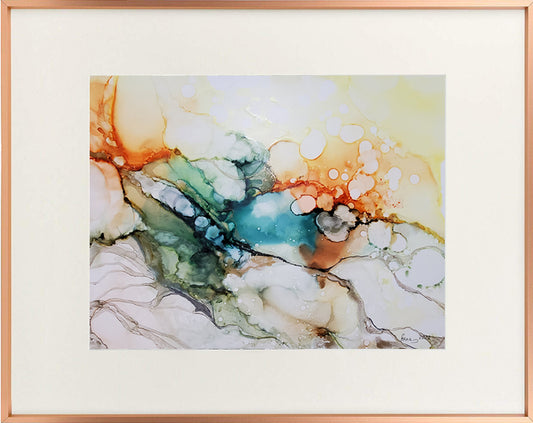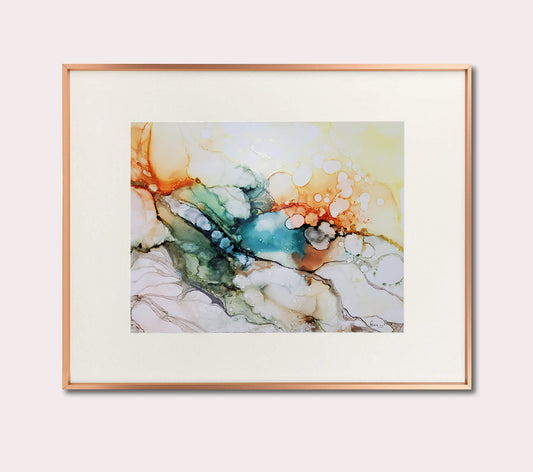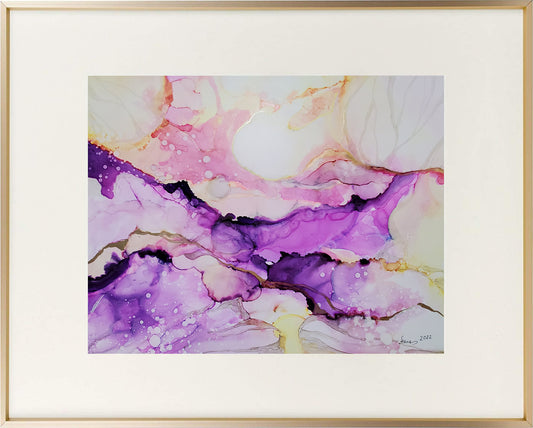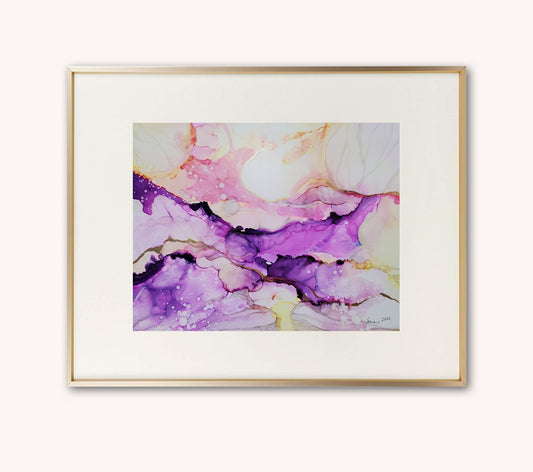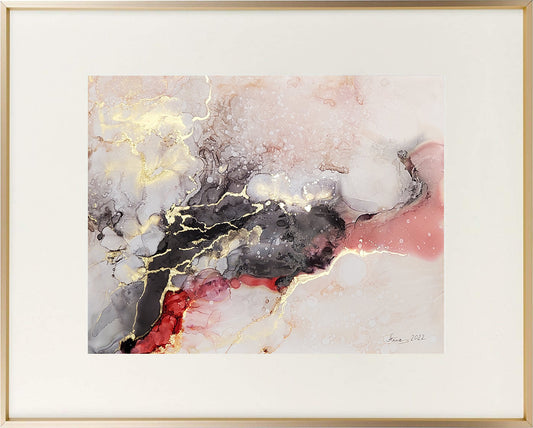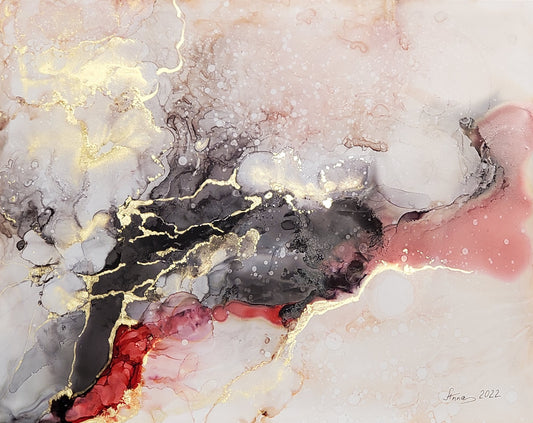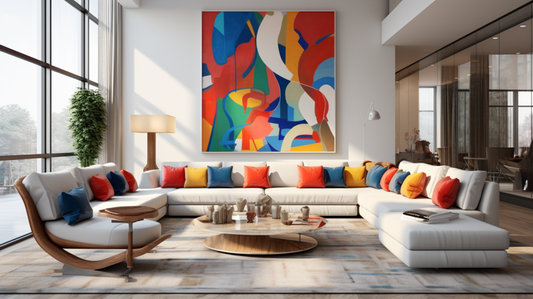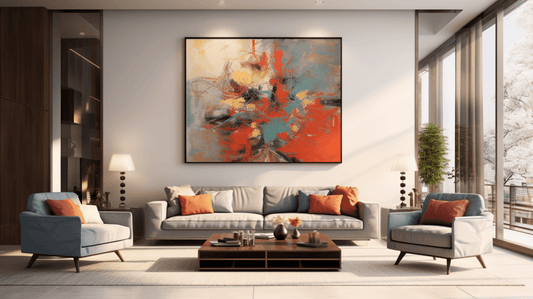
Abstract art, with its freedom of expression and diverse forms, has been a source of fascination for art lovers and interior decorators alike. Choosing the right abstract art for your home can be a rewarding and transformative experience, but it can also be a challenging task. Abstract art offers a wide range of styles, colors, and interpretations, making it important to consider various factors before making a selection. In this article, we will explore the world of abstract art, its significance in home decor, and provide you with a comprehensive guide on how to choose the right abstract art for your space. From understanding the basics of abstract art to matching it with your home's aesthetics and personal preferences, we'll delve into every aspect of this fascinating world.
Understanding Abstract Art
Before diving into the process of choosing the right abstract art for your home, it's crucial to understand what abstract art is and the various forms it can take. Abstract art is a departure from realistic depictions of the world, often characterized by non-representational and non-objective elements. Instead of trying to replicate a specific subject, abstract art focuses on the use of shapes, colors, lines, and textures to convey emotions, ideas, or concepts. The absence of a concrete subject allows for a broader range of interpretation and personal connection.
Abstract art can be broadly categorized into two main types: non-representational and non-objective. Non-representational abstract art does not represent any specific subject but relies on the use of form, color, and texture to create an emotional or conceptual impact. Non-objective abstract art, on the other hand, goes even further, eliminating any reference to the physical world entirely. It is purely a product of the artist's imagination and creativity, often without any external influences.
Examples of famous non-representational abstract artists include Wassily Kandinsky, Piet Mondrian, and Jackson Pollock, while artists like Kazimir Malevich and Theo van Doesburg are known for their non-objective works.
Choosing the Right Abstract Art
Now that we have a basic understanding of abstract art, let's delve into the process of choosing the right abstract art for your home. This selection should be a thoughtful and personal journey, taking into consideration your personal taste, the existing decor of your space, and the emotional impact you wish to achieve.
Personal Taste and Connection
One of the most crucial aspects of choosing abstract art for your home is to consider your personal taste and connection to the artwork. Abstract art is highly subjective, and what resonates with one person may not resonate with another. Take the time to explore various styles of abstract art, attend art exhibitions, and visit galleries to get a sense of what you are drawn to. Do you prefer bold and vibrant compositions, or are you more inclined towards subtle and minimalistic pieces? Understanding your personal taste will guide your selection process.
For example, if you are drawn to the vibrant and dynamic works of Jackson Pollock, you might consider acquiring a colorful, action painting-style piece for your living room, creating a focal point that reflects your energetic personality.

Existing Decor and Space
Consider the existing decor and the physical space where the artwork will be displayed. Your abstract art should harmonize with the overall aesthetic of your home. For instance, if you have a modern and minimalist interior, you may want to opt for abstract art with clean lines, simple forms, and a limited color palette to maintain a cohesive look. On the other hand, if your home has a more eclectic or traditional style, you might have more flexibility in choosing abstract art with varied styles and color schemes.
To illustrate, if you have a contemporary and minimalistic dining room with a monochromatic color scheme, a large black and white abstract painting with strong geometric shapes can create a striking contrast and serve as the focal point of the room.

Color Palette and Emotions
Color is a powerful element in abstract art that can evoke different emotions and moods. Consider the color palette of the artwork and how it resonates with the ambiance you want to create in your space. Bright, bold colors can bring energy and vibrancy, while soft, muted tones can promote a sense of tranquility and calm.
For instance, if you want to infuse your bedroom with a sense of serenity and relaxation, you might opt for an abstract artwork dominated by soothing blues and greens, like the works of Mark Rothko. Conversely, if you want to create an energetic and stimulating atmosphere in your home office, you may choose abstract art with fiery reds and oranges.
Size and Scale
The size and scale of the abstract art piece should complement the size of the wall or space where it will be displayed. A small artwork might get lost on a large, empty wall, while an oversized piece can overwhelm a small room. It's essential to strike a balance between the artwork and the space to create visual harmony.
For example, a spacious living room with high ceilings would benefit from a large-scale abstract painting, providing a sense of drama and grandeur. Conversely, a smaller abstract art piece may be better suited for a hallway or a cozy reading nook.

Composition and Style
Abstract art comes in various styles and compositions, ranging from geometric and linear to organic and fluid. The composition of the artwork should align with your personal taste and the existing decor of your home. Geometric abstract art, characterized by clean lines and geometric shapes, can complement modern and minimalistic interiors, while more organic and fluid compositions may be a better fit for eclectic and bohemian spaces.
As an example, if your home features mid-century modern furniture and design elements, you may opt for abstract art that embraces the geometric and linear style of artists like Josef Albers or Bridget Riley to enhance the retro feel of your space.

Artist's Reputation and Value
Consider the reputation and value of the artist whose work you are interested in acquiring. While the primary goal of selecting abstract art is personal satisfaction, it's worth noting that certain artists' works may appreciate in value over time. Art by well-established artists may not only enrich your living environment but also serve as an investment.
For instance, acquiring a piece by an artist like Mark Rothko or Willem de Kooning not only adds artistic value to your home but also has the potential to appreciate in value over the years, making it a wise investment.
Budget and Alternatives
Your budget is an important factor in the selection process. If you have a limited budget, consider alternatives like high-quality prints or reproductions of renowned abstract artworks. These can still provide the aesthetic appeal and emotional connection you seek without the investment associated with original pieces.
To illustrate, if you are on a tight budget but admire the works of Wassily Kandinsky, you can explore high-quality prints or posters of his paintings to add a touch of his vibrant and energetic style to your home.
Support Emerging Artists
Supporting emerging artists can be a fulfilling and unique way to acquire abstract art for your home. Emerging artists often offer fresh and innovative perspectives, and their works can be more affordable than those of established artists. By investing in emerging talent, you not only contribute to the art community but also have the opportunity to own unique pieces that may gain value over time.
For example, you can discover emerging abstract artists through local art galleries, art fairs, or online platforms like Etsy, where you can explore a variety of styles and connect directly with artists.
Art Curation and Placement
Once you have chosen the right abstract art for your home, the next step is to curate and place it effectively. Consider the following tips for art curation and placement:
- Focal Point: Make your abstract art a focal point in the room by placing it on a wall that draws attention, such as the wall behind a sofa or above a fireplace.
- Lighting: Adequate lighting is essential to showcase the artwork properly. Use accent lighting, such as track lights or picture lights, to illuminate the artwork and enhance its visual impact.
- Grouping: If you have a collection of abstract artworks, consider creating a gallery wall with a cohesive theme or style. Grouping artworks can create a visually stunning and dynamic effect.
- Eye Level: Hang the artwork at eye level, typically around 57-60 inches from the floor to the center of the artwork. This ensures that the art is easily viewable and engages the viewer.
- Balance: Consider the balance of the room and the composition of the artwork when placing it. Ensure that the artwork complements the other elements in the room, such as furniture and decor.
To illustrate, if you have selected a collection of smaller abstract paintings with a similar color scheme, you can arrange them in a grid pattern on a bedroom wall to create a cohesive and visually appealing display.
Choosing the right abstract art for your home is a deeply personal and creative process. It involves a blend of your personal taste, the existing decor of your space, and the emotional impact you wish to achieve. By understanding the fundamentals of abstract art, considering elements like color, composition, and style, and exploring various artists and alternatives, you can make an informed and meaningful choice. Whether you aim to create a serene and contemplative atmosphere in your bedroom or infuse your living room with energy and vibrancy, the world of abstract art offers a diverse range of options to suit your preferences.
Remember that the selection of abstract art for your home is an opportunity to express yourself, enhance your living environment, and engage with the transformative power of art. Whether you opt for the works of renowned artists or support emerging talent, your choice of abstract art can bring beauty, inspiration, and a unique character to your living spaces, making your home a reflection of your own artistic sensibilities.
Intrigued by the fascinating world of abstract art? Your artistic journey doesn't have to end here. Explore a mesmerizing collection of captivating and modern abstract artworks by visiting our Abstract Art Collection and Shop. Our gallery is a treasure trove of creativity, where you can not only see but also acquire unique pieces that resonate with your aesthetic sensibilities. Dive into a realm of imagination, emotion, and innovation as you discover the transformative power of abstract art. Don't miss the opportunity to enrich your surroundings with these thought-provoking creations. Start your exploration now and let the art on this page inspire your soul.

